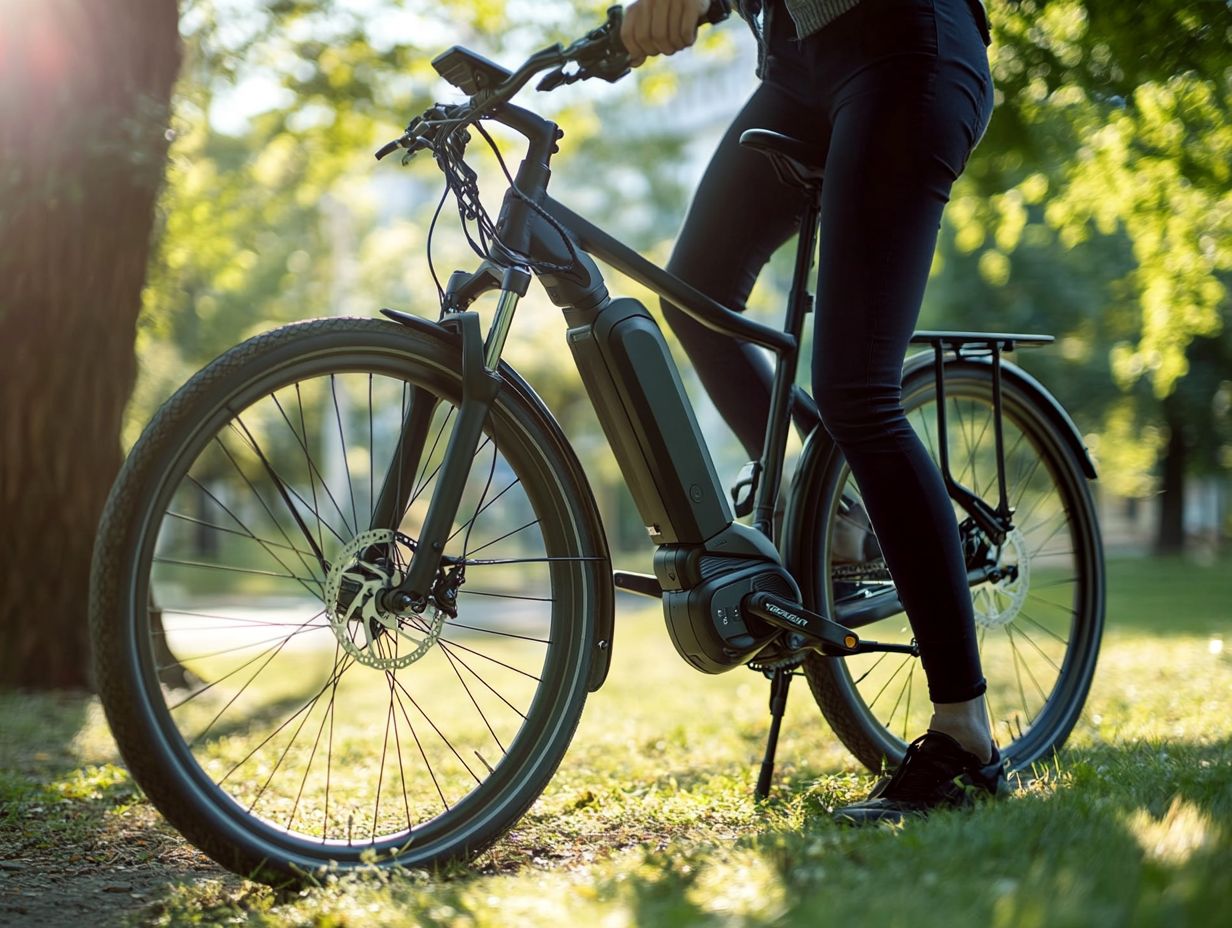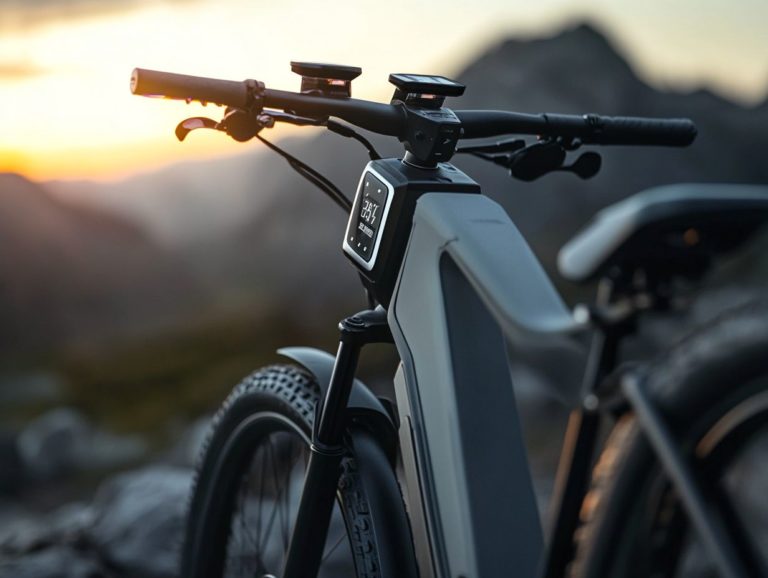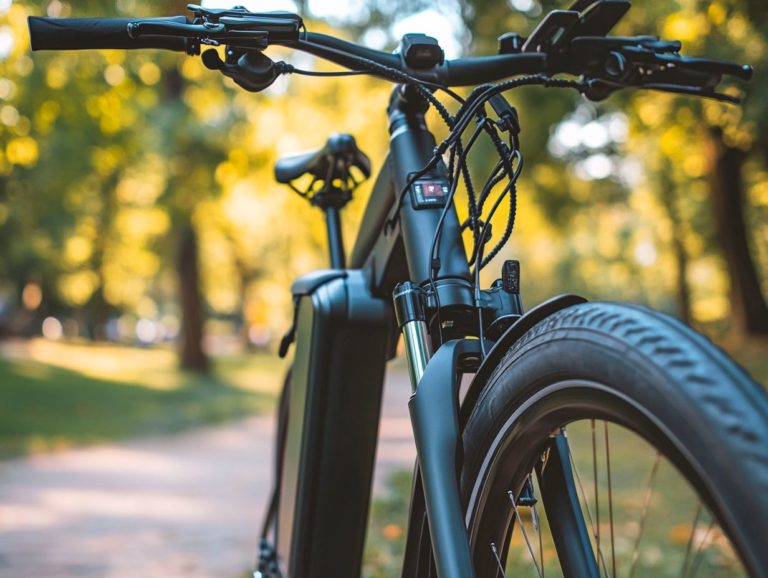What is the Best Way to Charge an E-Bike?
E-bikes have surged in popularity, offering you a convenient and eco-friendly way to navigate your world. Understanding their power source e-bike batteries is essential for maximizing both performance and longevity.
This guide will show you the various types of e-bike batteries, the key factors influencing their range and lifespan, and effective charging methods. You’ll uncover tips for proper maintenance and storage, explore alternative charging options like solar energy, and identify common pitfalls to avoid.
Whether you re a seasoned rider or just starting out, this information will empower you to get the most out of your e-bike experience, especially in terms of utility cycling.
Contents
Key Takeaways:

- Always use the recommended charger and charging method for your specific e-bike battery type to ensure optimal performance and longevity.
- Proper storage and regular maintenance of your e-bike battery can significantly extend its lifespan and save you money in the long run.
- Consider eco-friendly charging options such as solar charging to reduce your carbon footprint and save on electricity costs while charging your e-bike.
Understanding E-Bike Batteries
Understanding e-bike batteries is crucial if you’re aiming to elevate your experience with electric bicycles and enjoy the powerful boost they can provide. These modern lithium batteries are powerful and safe, typically equipped with a battery management system, which helps enhance performance and safety while minimizing risks like battery fires.
By grasping the various factors that influence range, lifespan, and charging cycles, you can ensure that your e-bike delivers a robust boost for your utility cycling needs. Understanding proper maintenance is important for enhancing the longevity of your battery.
Types of E-Bike Batteries
Several types of batteries are used in e-bikes, but lithium batteries reign supreme due to their efficiency and lightweight nature.
This preference for lithium-ion technology stems from its impressive energy density, enabling you to enjoy longer rides without the cumbersome weight of traditional battery types. Among the various lithium options, the 18650 cells are particularly noteworthy for their reliability and compact design, making them the go-to choice for both manufacturers and enthusiasts.
The importance of advanced battery technology cannot be overstated, as it directly impacts the performance and handling of your e-bike. A lighter battery enhances user convenience and significantly improves maneuverability and the overall riding experience.
This allows you to navigate urban landscapes or tackle rugged trails with seamless ease.
Factors Affecting Battery Life
Several factors can significantly influence the lifespan of your e-bike battery, including your usage patterns, charging cycles, and how you maintain and store it.
By understanding these elements, you can greatly enhance the efficiency and longevity of your electric bicycle’s power source. For instance, if you frequently deep discharge your battery, you may notice quicker degradation. In contrast, more moderate usage typically extends its life. To learn more about maintaining your battery, check out this guide on how to care for your e-bike battery.
How you charge your e-bike battery is equally important. Avoid overcharging or letting your battery completely deplete, as this plays a crucial role in its performance. Storing your batteries properly in a cool, dry place can also mitigate the risk of damage, ensuring they remain in optimal condition for when you need them.
By being mindful of these factors, you can truly optimize your e-bike riding experience.
Charging an E-Bike Battery

Charging an e-bike battery correctly is essential for maintaining both optimal performance and safety. Mischarging it can lead to serious consequences, including the risk of battery fires.
Prioritizing proper charging practices not only enhances your e-bike experience but also safeguards your investment.
Get started on optimizing your e-bike battery today your rides will thank you!
Charging Methods and Techniques
You ll find a variety of charging methods available for e-bike batteries, each bringing its own set of advantages, energy costs, and efficiencies.
Standard wall chargers are a popular choice for charging batteries due to their convenience and affordability. They typically provide a slow, steady recharge at lower energy costs, making them an economical option for your everyday needs. For optimal performance, it’s important to follow best practices for e-bike charging.
If you’re in a rush, fast chargers can be a great solution, dramatically reducing charging time. This can be particularly beneficial if you need a quick power boost before heading out for a ride. If you’re curious about how long it takes to charge an e-bike, be aware that fast chargers often come with higher energy expenses and may exert additional strain on the system that helps monitor and maintain your battery’s health.
For those looking to embrace sustainability, solar charging offers an exciting eco-friendly option! By harnessing renewable energy, you can minimize energy costs, but it does require sufficient sunlight and the right equipment to optimize battery performance.
Ultimately, each charging method not only affects your energy expenses but also influences how effectively the battery management system can regulate and preserve the battery s health over time.
Tips for Maximizing Battery Life
To maximize the life of your e-bike battery, embrace a set of best practices focused on proper maintenance, storage, and usage habits. These strategies are essential for ensuring optimal efficiency and longevity of your e-bike battery.
- Store your batteries in a cool, dry place, away from direct sunlight; extreme temperatures can negatively impact both performance and durability.
- It s generally recommended to keep the battery charged between 20% and 80% to prevent unnecessary wear and overheating issues.
- Regularly check the battery management system for any potential issues, allowing for timely interventions.
- Routine maintenance, like cleaning terminals and ensuring secure connections, plays a vital role in keeping your battery operating smoothly.
Alternative Charging Options

Exploring alternative charging options for e-bike batteries offers you not just eco-friendly solutions but also the potential to significantly reduce your overall energy costs, aligning with the goals set by the Department of Energy. Embracing these innovative methods can enhance your riding experience while being kinder to both your wallet and the planet.
Solar Charging and Other Eco-Friendly Options
Solar charging is an exciting eco-friendly option for recharging your e-bike batteries, blending sustainability with impressive cost savings. This innovative method allows you to harness the sun’s energy, giving you the freedom to extend your travel range without being tethered to conventional electrical outlets.
With the latest advancements in solar panel technology, including flexible and lightweight designs supported by companies like Bosch, your e-bike can achieve remarkable efficiency and practicality. To ensure you maximize this potential, it’s important to know how to properly charge your electric bicycle battery. Brands like SunPower and EcoVolt are at the forefront, crafting high-quality solar solutions specifically for e-bike applications.
While the benefits are substantial think reduced carbon footprints and significant long-term savings it’s important to weigh potential drawbacks. You’ll need direct sunlight for optimal performance, and the initial investment in quality solar hardware from brands like Costco can be a consideration. However, when you compare solar charging to traditional methods, you’ll likely find that the convenience and sustainability it offers make it a compelling option for the eco-conscious traveler like yourself.
Don t wait, start exploring these charging methods today!
Common Charging Mistakes to Avoid
Avoiding common charging mistakes is crucial for preserving both the safety and longevity of your e-bike battery. Engaging in improper practices can result in serious safety concerns, including the risk of battery fires and potential damage to your e-bike motors.
Ensuring you follow best charging protocols will protect your investment and enhance your riding experience.
Potential Damage and How to Prevent It
Understanding potential damage to e-bike batteries helps you take preventative measures. These steps can extend battery life and ensure safe operation while considering battery recycling options.
By recognizing risks such as thermal runaway or battery fires, you can take calculated steps to safeguard both yourself and your investment. Thermal runaway is when a battery overheats, causing even more heat. This can lead to severe damage and even fires. Monitor battery health carefully, avoid exposing the battery to extreme temperatures, and use chargers specifically designed to prevent fire risk.
Regularly inspect the battery for signs of swelling or damage. This proactive measure can help reduce the risks of thermal runaway and fires. Storing your e-bike and its battery in cool, dry places can significantly mitigate the risk of overheating. Enjoy your ride with peace of mind!
Frequently Asked Questions

What is the Best Way to Charge an E-Bike?
Charging an e-bike is best done with the manufacturer’s charger plugged into a standard outlet. Always charge it fully before riding again.
Can I Charge My E-Bike with a Regular Phone Charger?
No, it is not recommended to use a regular phone charger to charge your e-bike. E-bike batteries require a higher voltage and wattage to charge properly, which a phone charger cannot provide. Always use the charger provided by the manufacturer.
How Long Does it Take to Charge an E-Bike?
The charging time for an e-bike can vary depending on the battery size and type, as well as the charger being used. On average, it can take anywhere from 3-6 hours to fully charge an e-bike battery.
Is it Bad to Leave My E-Bike Charging Overnight?
No, it is not recommended to leave your e-bike charging overnight. Once the battery is fully charged, it is important to unplug the charger to avoid overcharging the battery. Overcharging can lead to decreased battery life and performance.
Can I Ride My E-Bike While it is Charging?
No, it is not safe to ride your e-bike while it is charging. The charger should be unplugged from the bike before riding. Attempting to ride while the bike is charging can damage the battery and potentially cause harm to the rider.
Do I Need to Charge My E-Bike After Every Ride?
Charge your e-bike after every ride for best results, especially if you are using it for long distances or on hilly terrain. This will ensure that the battery is fully charged and ready for your next ride.
By following these guidelines, you can enjoy a safe and long-lasting e-bike experience!






